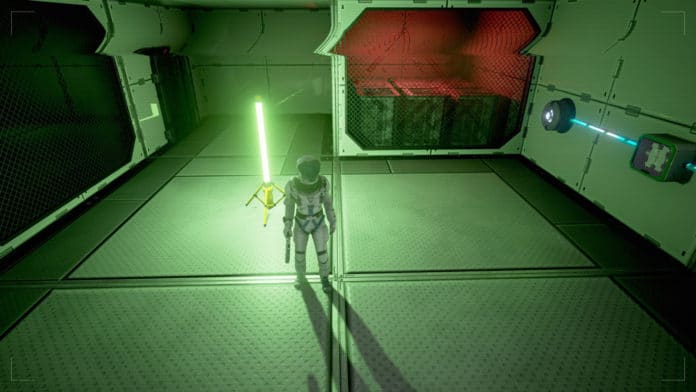“The Turing Test”
Developed by: Bulkhead Interactive
Published by: Square Enix
Available on: PC, Xbox One
—
For millennia, our species has understood that what helps separate us from the animal kingdom is our ability to articulate abstract phenomena, like a fear of death in the absence of an immediate cause for alarm. But is our intelligence reducible to our biology? In the computer age, this question has assumed greater urgency since people such as Stephen Hawking have warned that unscrupulous research into artificial intelligence could pose a threat toward the human race.
The idea of an untamed A.I. has energized the popular imagination for some time. In film, there are archetypes like HAL 9000 from “2001: A Space Odyssey” and the eponymous Terminator. And in video games, where there is no shortage of rogue A.I.’s, “Metroid’s” Mother Brain and “Portal’s ” GLaDOS stand out as two of the most iconic. With so much competition, it’s a minor wonder that Bulkhead Interactive, the Derby-based U.K. studio, has found in “The Turing Test” a meaningful way to explore this motif.
In the game, you play as Ava, an engineer who has been revived from cryogenic rest by TOM the A.I. on a space station. The station is a satellite orbiting Europa – Jupiter’s sixth closest moon. TOM tells Ava that communication has been lost with a ground team and that it’s imperative that she assist in finding them. After landing on Europa, it becomes evident that the robotically built base where the astronauts were last spotted has been given an interior makeover. Specifically, the base’s rooms have been reconfigured into puzzles or Turing Tests meant to differentiate machines from humans.
Turing Tests owe their real-world status to the ideas raised by Alan Turing, the famed 20th-century mathematician who was a pioneer of computer science. In his article, “Computing Machinery and Intelligence,” published in the October 1950 issue of “Mind,” Turing suggested that it should be possible to one day program a computer to act in a way that was indistinguishable from an actual person. As an example, he imagined a computer playing a version of the imitation game – a parlor game in which a man and a woman retreat into two separate rooms and the man is charged with impersonating the woman. The challenge for the guests is to identify which of the two people in the two closed rooms is a woman when all they have to go on are typewritten responses to their questions slipped under a door. Turing hypothesized that it should be possible “in about 50 years” for a computer to “play the imitation game so well that an average interrogator will not have more than a 70 percent chance of making the right identification after five minutes of questioning.”
In “The Turing Test,” the imitation game is subjected to an ironic reversal. There is a computer on the base of Europa that the player can interact with that’s convinced the player is a robot.
In the years since Turing proposed his criteria to demonstrate machine “thinking,” his arguments have inspired several critiques, perhaps none more famous than John Searle’s Chinese room thought experiment, which is materially rendered in the game. In his paper, “Minds, Brains, and Programs,” Searle argued that just because a machine could be programmed to fool one into thinking that one was conversing with a human, it would be wrong to say that this constituted a display of genuine thought. As an example, he imagined himself in a closed room surrounded by reference materials where he receives batches of paper written in Chinese. Using the reference materials, he, who knows no Chinese, is able to copy out appropriate responses to the messages he has been given and slip them back outside. According to Searle, though it might look to an unsuspecting observer as though a meaningful conversation were taking place in Chinese, this is an illusion because he is “manipulating uninterpreted formal signs.” His understanding of Chinese is, in other words, akin to a computer program.
“The Turing Test” dramatizes the concept of machine thinking by creating a scenario in which it may be said that an A.I. demonstrates a higher level of moral reasoning than the humans around it. Over the course of the game, the player learns that the missing ground crew and TOM had a disagreement after they discovered an organism which TOM reasonably contends should not leave Europa.
The narrative brilliantly plays with the TOM’s ability to exhibit human fallibilities such as doubt, conflicts in synthesizing information, and conflicting memories. It is TOM who explains to Ava the significance of the Turing tests and, while recognizing his own limitations, claims elsewhere an equal status as a thinking entity.
The puzzles in the game are exquisite. They are meant to demonstrate the power of lateral thinking – what machines can’t do. In this way, the game calls attention to some of the fundamental cognitive practices involved in gaming. The player is made to reflect on the fact that Ava has been tasked with learning rules – for example, that blue power spheres provide a continuous flow of electricity while green spheres generate it on and off – that must be combined in creative ways to demonstrate a meaningful, as opposed to a haphazard, understanding of the underlying logic of the puzzles she encounters.
“The Turing Test” achieves a rare harmony of gameplay and narrative. It should make one think about the flexibility of the mind and what it means to consider one’s species the apex of creation.






